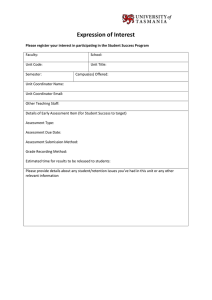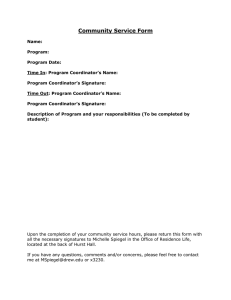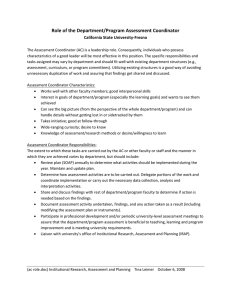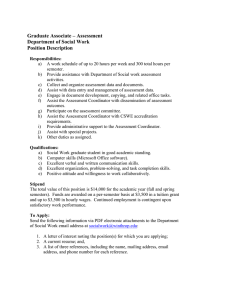Reliability Standard
advertisement
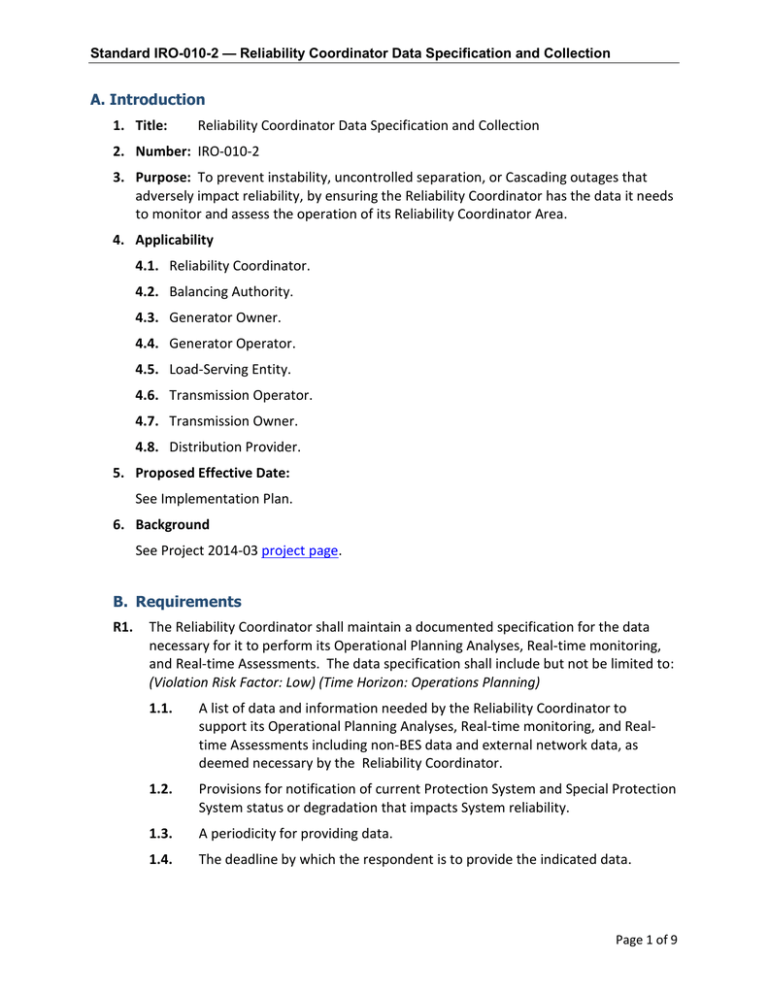
Standard IRO-010-2 — Reliability Coordinator Data Specification and Collection A. Introduction 1. Title: Reliability Coordinator Data Specification and Collection 2. Number: IRO-010-2 3. Purpose: To prevent instability, uncontrolled separation, or Cascading outages that adversely impact reliability, by ensuring the Reliability Coordinator has the data it needs to monitor and assess the operation of its Reliability Coordinator Area. 4. Applicability 4.1. Reliability Coordinator. 4.2. Balancing Authority. 4.3. Generator Owner. 4.4. Generator Operator. 4.5. Load-Serving Entity. 4.6. Transmission Operator. 4.7. Transmission Owner. 4.8. Distribution Provider. 5. Proposed Effective Date: See Implementation Plan. 6. Background See Project 2014-03 project page. B. Requirements R1. The Reliability Coordinator shall maintain a documented specification for the data necessary for it to perform its Operational Planning Analyses, Real-time monitoring, and Real-time Assessments. The data specification shall include but not be limited to: (Violation Risk Factor: Low) (Time Horizon: Operations Planning) 1.1. A list of data and information needed by the Reliability Coordinator to support its Operational Planning Analyses, Real-time monitoring, and Realtime Assessments including non-BES data and external network data, as deemed necessary by the Reliability Coordinator. 1.2. Provisions for notification of current Protection System and Special Protection System status or degradation that impacts System reliability. 1.3. A periodicity for providing data. 1.4. The deadline by which the respondent is to provide the indicated data. Page 1 of 9 Standard IRO-010-2 — Reliability Coordinator Data Specification and Collection M1. The Reliability Coordinator shall make available its dated, current, in force documented specification for data. R2. The Reliability Coordinator shall distribute its data specification to entities that have data required by the Reliability Coordinator’s Operational Planning Analyses, Realtime monitoring, and Real-time Assessments. (Violation Risk Factor: Low) (Time Horizon: Operations Planning) M2. The Reliability Coordinator shall make available evidence that it has distributed its data specification to entities that have data required by the Reliability Coordinator’s Operational Planning Analyses, Real-time monitoring, and Real-time Assessments. This evidence could include but is not limited to web postings with an electronic notice of the posting, dated operator logs, voice recordings, postal receipts showing the recipient, date and contents, or e-mail records. R3. Each Reliability Coordinator, Balancing Authority, Generator Owner, Generator Operator, Load-Serving Entity, Transmission Operator, Transmission Owner, and Distribution Provider receiving a data specification in Requirement R2 shall satisfy the obligations of the documented specifications using: (Violation Risk Factor: Medium) (Time Horizon: Operations Planning, Same-Day Operations, Real-time Operations) 3.1 A mutually agreeable format 3.2 A mutually agreeable process for resolving data conflicts 3.3 A mutually agreeable security protocol M3. The Reliability Coordinator, Balancing Authority, Generator Owner, Generator Operator, Load-Serving Entity, Reliability Coordinator, Transmission Operator, Transmission Owner, and Distribution Provider receiving a data specification in Requirement R2 shall make available evidence that it satisfied the obligations of the documented specification using the specified criteria. Such evidence could include but is not limited to electronic or hard copies of data transmittals or attestations of receiving entities. C. Compliance 1. Compliance Monitoring Process 1.1. Compliance Enforcement Authority As defined in the NERC Rules of Procedure, “Compliance Enforcement Authority” (CEA) means NERC or the Regional Entity in their respective roles of monitoring and enforcing compliance with the NERC Reliability Standards. 1.2 Compliance Monitoring and Assessment Processes As defined in the NERC Rules of Procedure, “Compliance Monitoring and Assessment Processes” refers to the identification of the processes that will be used to evaluate Page 2 of 9 Standard IRO-010-2 — Reliability Coordinator Data Specification and Collection data or information for the purpose of assessing performance or outcomes with the associated reliability standard. 1.3. Data Retention The Reliability Coordinator, Balancing Authority, Generator Owner, Generator Operator, Load-Serving Entity, Transmission Operator, Transmission Owner, and Distribution Provider shall each keep data or evidence to show compliance as identified below unless directed by its Compliance Enforcement Authority to retain specific evidence for a longer period of time as part of an investigation: The Reliability Coordinator shall retain its dated, current, in force documented specification for the data necessary for it to perform its Operational Planning Analyses, Real-time monitoring, and Real-time Assessments for Requirement R1, Measure M1 as well as any documents in force since the last compliance audit. The Reliability Coordinator shall keep evidence for three calendar years that it has distributed its data specification to entities that have data required by the Reliability Coordinator’s Operational Planning Analyses, Real-time monitoring, and Real-time Assessments for Requirement R2, Measure M2. Each Reliability Coordinator, Balancing Authority, Generator Owner, Generator Operator, Interchange Authority, Load-Serving Entity, Transmission Operator, Transmission Owner, and Distribution Provider receiving a data specification shall retain evidence for the most recent 90-calendar days that it has satisfied the obligations of the documented specifications in accordance with Requirement R3 and Measurement M3. The Compliance Enforcement Authority shall keep the last audit records and all requested and submitted subsequent audit records. 1.4. Additional Compliance Information None. Page 3 of 9 Standard IRO-010-2 — Reliability Coordinator Data Specification and Collection Table of Compliance Elements R# R1 Time Horizon VRF Operations Planning Low Violation Severity Levels Lower Moderate High Severe The Reliability Coordinator did not include one of the parts (Part 1.1 through Part 1.4) of the documented specification for the data necessary for it to perform its Operational Planning Analyses, Real-time monitoring, and Realtime Assessments. The Reliability Coordinator did not include two of the parts (Part 1.1 through Part 1.4) of the documented specification for the data necessary for it to perform its Operational Planning Analyses, Real-time monitoring, and Real-time Assessments. The Reliability Coordinator did not include three of the parts (Part 1.1 through Part 1.4) of the documented specification for the data necessary for it to perform its Operational Planning Analyses, Real-time monitoring, and Real-time Assessments. The Reliability Coordinator did not include any of the parts (Part 1.1 through Part 1.4) of the documented specification for the data necessary for it to perform its Operational Planning Analyses, Real-time monitoring, and Real-time Assessments. OR, The Reliability Coordinator did not have a documented specification for the data necessary for it to perform its Operational Planning Analyses, Real-time Page 4 of 9 Standard IRO-010-2 — Reliability Coordinator Data Specification and Collection R# Time Horizon VRF Violation Severity Levels Lower Moderate High Severe monitoring, and Real-time Assessments. For the Requirement R2 VSLs only, the intent of the SDT is to start with the Severe VSL first and then to work your way to the left until you find the situation that fits. In this manner, the VSL will not be discriminatory by size of entity. If a small entity has just one affected reliability entity to inform, the intent is that that situation would be a Severe violation. R2 Operations Planning Low The Reliability Coordinator did not distribute its data specification as developed in Requirement R1 to one entity, or 5% or less of the entities, whichever is greater, that have data required by the Reliability Coordinator’s Operational Planning Analyses, Real-time monitoring, and Realtime Assessments. The Reliability Coordinator did not distribute its data specification as developed in Requirement R1 to two entities, or more than 5% and less than or equal to 10% of the reliability entities, whichever is greater, that have data required by the Reliability Coordinator’s Operational Planning Analyses, and Realtime monitoring, and Real-time The Reliability Coordinator did not distribute its data specification as developed in Requirement R1 to three entities, or more than 10% and less than or equal to 15% of the reliability entities, whichever is greater, that have data required by the Reliability Coordinator’s Operational Planning Analyses, Real-time The Reliability Coordinator did not distribute its data specification as developed in Requirement R1 to four or more entities, or more than 15% of the entities, whichever is greater, that have data required by the Reliability Coordinator’s Operational Planning Analyses, Real-time monitoring, and Real-time Page 5 of 9 Standard IRO-010-2 — Reliability Coordinator Data Specification and Collection R# R3 Time Horizon Operations Planning, Same-Day Operations, Real-time Operations VRF Violation Severity Levels Lower Medium The responsible entity receiving a data specification in Requirement R2 satisfied the obligations of the documented specifications for data but failed to follow one of the criteria shown in Parts 3.1 – 3.3. Moderate High Severe Assessments. monitoring, and Real-time Assessments. Assessments. The responsible entity receiving a data specification in Requirement R2 satisfied the obligations of the documented specifications for data but failed to follow two of the criteria shown in Parts 3.1 – 3.3. The responsible entity receiving a data specification in Requirement R2 satisfied the obligations of the documented specifications for data but failed to follow any of the criteria shown in Parts 3.1 – 3.3. The responsible entity receiving a data specification in Requirement R2 did not satisfy the obligations of the documented specifications for data. Page 6 of 9 Standard IRO-010-2 — Guidelines and Technical Basis D. Regional Variances None E. Interpretations None F. Associated Documents None Version History Version Date Action Change Tracking 1 October 17, 2008 Adopted by Board of Trustees New 1a August 5, 2009 Added Appendix 1: Interpretation of R1.2 and R3 as approved by Board of Trustees Addition 1a March 17, 2011 Order issued by FERC approving IRO010-1a (approval effective 5/23/11) 1a 2 November 19, 2013 Updated VRFs based on June 24, 2013 approval Revisions pursuant to Project 2014-03 April 2014 2 November 13, 2014 Adopted by NERC Board of Trustees 2 November 19, 2015 FERC approved IRO-010-2. Docket No. RM15-16-000 Revisions under Project 2014-03 Page 7 of 9 Standard IRO-010-2 — Guidelines and Technical Basis Guidelines and Technical Basis Rationale: During development of this standard, text boxes were embedded within the standard to explain the rationale for various parts of the standard. Upon BOT adoption, the text from the rationale text boxes was moved to this section. Rationale for Definitions: Changes made to the proposed definitions were made in order to respond to issues raised in NOPR paragraphs 55, 73, and 74 dealing with analysis of SOLs in all time horizons, questions on Protection Systems and Special Protection Systems in NOPR paragraph 78, and recommendations on phase angles from the SW Outage Report (recommendation 27). The intent of such changes is to ensure that Real-time Assessments contain sufficient details to result in an appropriate level of situational awareness. Some examples include: 1) analyzing phase angles which may result in the implementation of an Operating Plan to adjust generation or curtail transactions so that a Transmission facility may be returned to service, or 2) evaluating the impact of a modified Contingency resulting from the status change of a Special Protection Scheme from enabled/in-service to disabled/out-of-service. Rationale for Applicability Changes: Changes were made to applicability based on IRO FYRT recommendation to address the need for UVLS and UFLS information in the data specification. The Interchange Authority was removed because activities in the Coordinate Interchange standards are performed by software systems and not a responsible entity. The software, not a functional entity, performs the task of accepting and disseminating interchange data between entities. The Balancing Authority is the responsible functional entity for these tasks. The Planning Coordinator and Transmission Planner were removed from Draft 2 as those entities would not be involved in a data specification concept as outlined in this standard. Rationale: Proposed Requirement R1, Part 1.1: Is in response to issues raised in NOPR paragraph 67 on the need for obtaining non-BES and external network data necessary for the Reliability Coordinator to fulfill its responsibilities. Proposed Requirement R1, Part 1.2: Is in response to NOPR paragraph 78 on relay data. Proposed Requirement R3, Part 3.3: Page 8 of 9 Standard IRO-010-2 — Guidelines and Technical Basis Is in response to NOPR paragraph 92 where concerns were raised about data exchange through secured networks. Corresponding changes have been made to proposed TOP-003-3. Page 9 of 9
